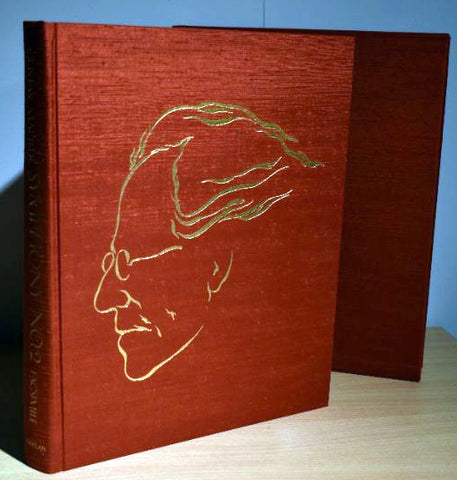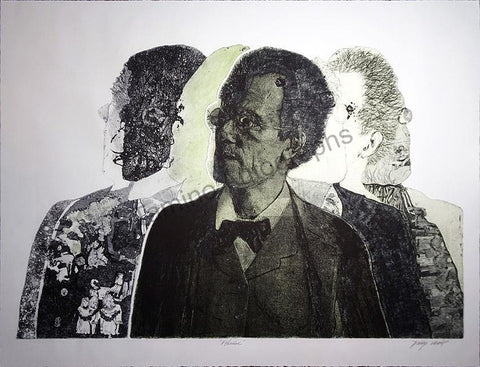Gustav Mahler Symphony 2 "Resurrection": The Gilbert Kaplan Story August 19 2022
Music has touched the hearts and lives of people since its beginnings. It's a way to explore the most profound feelings and mysteries of the human experience and bring people together. Almost everyone has a story or two regarding how a particular piece of music touched their soul at one time or another.
However, the story of Gilbert Kaplan's passion for Gustav Mahler's Symphony No. 2 "Resurrection" is a testament to how a single musical composition can transform a life.
TRAINING AND EARLY DAYS OF GUSTAV MAHLER
Romantic composer and conductor Gustav Mahler was born in 1860 in Bohemia, in the Austrian Empire, and showed great talent and proficiency in music from a young age. He began to compose his own works as young as four. By the time he was ten years old, he had made his debut as a pianist. At 15, Mahler gained acceptance into the Vienna Conservatory and began his formal training.
[CLICKABLE IMAGE] A young Gustav Mahler - Photo postcard signed by him.
After his time at the Vienna Conservatory was over, Mahler worked as a conductor for seventeen years and began to create his own works. Mahler composed ten symphonies and many songs throughout his life before he died in Austria in 1911.
There was little recognition for the genius of Mahler's work during the 50 years immediately following his death. It was only later that he gained his due acknowledgment as one of the forebears of twentieth-century musical composition techniques. His influence is noticeable in the works of composers such as Benjamin Britten, Arnold Schoenberg, and Dimitri Shostakovitch.
COMPOSITION AND MEANING BEHIND "RESURRECTION"
Mahler composed "Resurrection" between 1888 and 1894. The piece was first performed in 1895 and was one of the most popular and successful works that Mahler wrote. The heart of the composition explores the meaning of life and death. The piece takes place in the key of C minor, and a full performance lasts up to 90 minutes. It consists of five movements and takes an impressive orchestra of 100 with a choir of up to 200 members to perform correctly.
Mahler stated that the purpose behind this composition was to explore the true meaning of life while trying to answer some difficult questions. Why are we here? Why do we suffer? Is it all a joke? These are some of the key concepts that Mahler was attempting to explore. He thought that finding the answers to these queries was necessary for living a full life and even dying. The questions were presented at the beginning of "Resurrection," and Mahler did his best to answer them as well as he could in the finale.
[CLICKABLE IMAGE] Rare contract signed in 1898 by Mahler as Director of the Vienna Court Opera (a position he held for 10 years, starting in 1897).
The complex and often dark subject matter that inspired "Resurrection" explains the urgent and expansive emotion conveyed throughout. In addition, the moody and constantly changing nature and tone of the music is one of the reasons that the piece captured the attention of Gilbert Kaplan so fully.
GILBERT KAPLAN HEARS MAHLER'S MUSIC AND FALLS IN LOVE
Gilbert Kaplan was a magazine publisher in New York City who became an amateur conductor. His love for a particular piece of music was so great that he decided his purpose in life was to conduct it with a full orchestra. He used his financial resources and determination to turn his dream into a reality.
The millionaire and businessman first heard of Mahler in 1965 when he was just 25 years old. A friend of his asked Kaplan to accompany him to a rehearsal of the American Symphony Orchestra at Carnegie Hall in New York. Kaplan attended and was so moved by what he heard that he went out and bought a ticket for the concert.
[CLICKABLE IMAGE] Program for the World Premiere (1910) of Mahler's Symphony #8 "Of A Thousand" conducted by the composer himself
He became overcome with emotion during the performance. Kaplan believed that he understood the meaning that Mahler was trying to convey in "Resurrection" and set out to make an authentic recording of the piece.
He describes Mahler's composition as a tribute to the contradictions of life. "Resurrection," he believes, mirrors many aspects of human life and makes one feel exposed, inviting personal contemplation of the meaning of life and death. These are challenging subjects to think about and require great introspection and vulnerability.
Kaplan is not religious himself and feels that the true power of Mahler's work goes beyond contemplating what to expect after death. It is, instead, the ability to combine the entire breadth of human emotions and touch upon some of the most personal of matters. This triggers a profound reaction and brings up deep feelings in even the most staunch cynic.
He believes that Mahler was trying to get across to his audience a sense of rebirth by affirming that every individual should do their best to live life to the fullest. Everyone's time on earth is fleeting, and Mahler pointed out the folly of wasting time worrying about what comes after death instead of living life.
KAPLAN'S JOURNEY TO CONDUCT "RESURRECTION"
Before his introduction to "Resurrection," Kaplan had never heard of Mahler or listened to any of his works performed. So his decision to learn to conduct the piece was shocking. He had no formal training in music or conducting himself, and even experienced conductors struggled with the piece. But, he knew that the journey he was about to undertake was about more than just the music. Kaplan had found meaning and purpose in his experience and needed to answer the call.
Gilbert Kaplan decided that he wanted to conduct "Resurrection" as a way to truly feel the music in its entirety and to get an even deeper understanding of what Mahler was trying to convey. So he chose to learn everything he could about Mahler by speaking with authorities on his life and music, as well as traveling everywhere he could to listen to live performances.
[CLICKABLE IMAGE] Beautiful book published by the Kaplan Foundation (1986) the original manuscript of this symphony is presented in full score with original instrumentation, bar-numbered movements, and ample margins for notes.
Kaplan hired Charles Zachary Bornstein in 1981 as his tutor and spent a full eight hours every day of the summer in training. When summer came to an end, he still devoted two to three hours per day to his studies. His lack of previous knowledge and training drove him to work even harder and commit himself to mastering the art so that he could do justice to his favorite musical score.
In 1982, Kaplan rented Avery Fisher Hall in New York. It was here that he performed his debut and conducted Mahler's Symphony No.2 by memory in front of his audience. Kaplan has stated that he had serious doubts about his ability to pull off the feat. He even planned to direct everyone's attention to the dinner that was waiting for them should he fail. In the end, Kaplan's worries were completely unfounded.
His performance was a huge success. In fact, he was asked to conduct the piece again with the American Symphony Orchestra and many others.
A LIFELONG TRIBUTE TO MAHLER AND "RESURRECTION"
From the moment Gilbert Kaplan first heard Mahler's music performed on that fateful day in 1965, he devoted much of his life to researching and understanding the composer. He believed that he had a purpose and a mission to bring the music of Mahler to the world.

His story is known throughout the musical community and was even made into a documentary titled "Gil Kaplan: Mahler & the Millionaire" by the BBC Review in 1983. Before his death in 2016, Kaplan conducted "Resurrection" for 100 live performances. It was the only work he ever conducted in public. He also recorded the piece on two occasions. First with the London Symphony Orchestra in 1987 and then with the Vienna Philharmonic in 2002.
One of the most well-known performances that Kaplan conducted was in 2008 when he led the New York Philharmonic. This achievement was a testament to years of hard work and fervent determination to give others a chance to hear Mahler's piece as Kaplan believed he intended it.
THE KAPLAN FOUNDATION
Gilbert Kaplan so firmly believed in the power of Mahler's compositions that he established the Kaplan Foundation. This organization aims to study and preserve Mahler's work, making it accessible to new generations. He jumped at the opportunity to purchase the original score when it became available and paid a sum of six figures for it. Kaplan took his role as custodian of "Resurrection" seriously.
He believed that the piece should be accessible for study by all who had an interest and placed it in the Pierpont Morgan Library in New York City. The Kaplan Foundation also published a facsimile version of the original score to make a study of the piece more widely available.
[CLICKABLE IMAGE] Abstract Intaglio Print of Gustav Mahler on Paper Signed by the American Printmaker Artist Philip von Raabe
Throughout his journey, Kaplan was occasionally labeled obsessive and even crazy due to his single-minded pursuit to understand and conduct "Resurrection" to the best of his ability. While some critics may believe that his devotion was over-the-top, few can argue that his love for the music of Mahler was genuine and profound. He dedicated a significant portion of his life to making his dream of conducting "Resurrection" a reality and is an inspiration to many.
SEE ALSO:
- Gustav Mahler - 9th Symphony Facsimile Edition
- Gustav Mahler - 10th Symphony Facsimile Edition
- Gustav Mahler - 5th Symphony Adagietto Facsimile Edition
- Gustav Mahler - Abstract Intaglio Print on Paper Signed by Philip von Raabe
- Gustav Mahler: Symphony #2 "Resurrection" Manuscript Facsimile + 3 Signed Letters
- Gustav Mahler Signed Photograph
- Gustav Mahler - 1910 World Premiere Program Symphony 8
- The Schubertiade Music Festival (Blog)
- Frederic Chopin: The Funeral March Story (Blog)
- Bronislaw Huberman and the Orchestra of Exiles (Blog)
- Giacomo Puccini and the World Premiere of La Bohème (Blog)
Interested in authentic autographs?
SIGN UP for TAMINO AUTOGRAPHS NEWSLETTER







